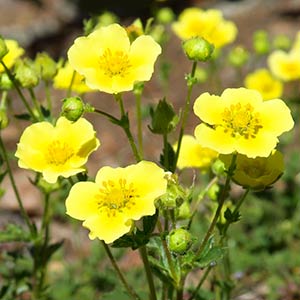Drymocallis arguta
Drymocallis pseudorupestris
cordilleran drymocallis, sticky cinquefoil, tall cinquefoil, tall drymocallis or wood beauty, tall wood-beauty
cliff drymocallis, cliff woodbeauty, false rock loving cinquefoil, Rocky Mountain sticky cinquefoil
short.
elongate.
usually solitary, sometimes tufted, (1–)3–10 dm;
base 3–6 mm diam., ± densely, sometimes sparsely, septate-glandular.
openly tufted to loosely spaced, (0.3–)0.6–4 dm;
base 1–3 mm diam., ± densely septate-glandular.
usually moderately to densely hairy;
basal (6–)12–40 cm, leaflet pairs (3–)4–5;
terminal leaflet broadly elliptic-obovate, (2–)4–10 × (1–)2–4.5 cm, teeth mostly double, 15–30+ per side, apex obtuse to acute;
cauline 2–3, relatively well developed, leaflet pairs 2–4.
glabrate or sparsely to ± densely hairy;
basal (2–)3–16 cm, leaflet pairs (2–)3–4(–5);
terminal leaflet broadly obovate-cuneate to flabellate, 0.2–3(–4) × 0.5–3 cm, teeth single or double, 2–15 per side, apex usually rounded to truncate, sometimes obtuse;
cauline 0–2, reduced, leaflet pairs 2–3.
10–40-flowered, not leafy, congested, sometimes more elongate in fruit, 1/10–1/5(–1/3) of stem, narrow, branch angles 5–20°.
2–40-flowered, not or ± leafy, open, 1/6–3/4(–4/5) of stem, ± wide, branch angles (10–)20–40(–50)°.
1–5 (proximal to 15) mm, densely short-hairy, septate-glandular.
3–20 (proximal to 40) mm, not or sparsely to moderately short-hairy, predominantly septate-glandular.
opening widely;
epicalyx bractlets ± elliptic, 4–6(–8) × 1–2 mm;
sepals spreading, (5–)7–10 mm, apex obtuse to acute, apiculate;
petals overlapping, spreading, cream-white to yellowish, broadly elliptic, (5–)7–9 × (5–)6–8 mm, ± equal to or slightly longer than sepals;
filaments 1.5–2.5 mm, anthers 0.7–1 mm;
styles thickened, 1 mm.
opening widely;
epicalyx bractlets linear to elliptic, 2–6 × 1–2 mm;
sepals spreading, 4–7(–9) mm, apex acute to obtuse, apiculate;
petals overlapping or not, spreading, cream-white to pale yellow (red-tinged in var. crumiana), narrowly to broadly obovate, 4–12 × 3–11 mm, longer than sepals;
filaments 1–4 mm, anthers 0.7–1.2 mm;
styles thickened, 1–1.5 mm.
light brown, 1 mm.
light brown, 1 mm.
= 14.
Drymocallis arguta
Drymocallis pseudorupestris
Drymocallis arguta is the only species of the genus occurring east of the Rocky Mountains, except for D. fissa in immediately adjacent prairies and the Black Hills of South Dakota. It is primarily a species of intact prairies and pasturelands throughout the Great Plains, extending as scattered populations in equivalent habitats throughout the northeastern states and adjacent provinces. Some of these states consider it a species of conservation concern (as Potentilla arguta, tall cinquefoil), and the sparsely hairy nature of some of these populations suggests that further taxonomic attention might be warranted. Drymocallis arguta occurs also in the Colorado Front Range, generally at elevations higher than D. fissa, with which it sometimes intergrades morphologically. It intergrades also with D. convallaria but tends to be larger, coarser, and more densely hairy with more acute leaflets.
(Discussion copyrighted by Flora of North America; reprinted with permission.)
Varieties 3 (3 in the flora).
Drymocallis pseudorupestris occurs from Alberta and Washington to California and Utah, mostly in montane habitats; it is the species most often associated with rocky habitats, including talus slopes, for which its relatively elongate caudex branches are an obvious adaptation. Vestiture is dominated by abundant septate glands on stems and in the inflorescences. Except for var. pseudorupestris, which occurs only in the northeastern part of the species range, plants are relatively short, usually less than 2.5 dm. Three intergrading varieties accommodate the extremes at the northeastern and southern ends of the range.
(Discussion copyrighted by Flora of North America; reprinted with permission.)
1. Stems (1–)2–4 dm, bases (1.5–)2–3 mm diam.; basal leaves (4–)7–16 cm; terminal leaflets (1–)2–3(–4) cm, teeth usually double, (5–)8–15 per side; flowers (5–)10–40; petals 6–12 × 5–11 mm, widely overlapping; filaments 2–4 mm. | var. pseudorupestris |
1. Stems (0.3–)0.6–2.5 dm, bases 1–2(–3) mm diam.; basal leaves (2–)3–9(–15) cm; terminal leaflets 0.2–2(–4) cm, teeth single or ± double, 2–8(–12) per side; flowers 2–12(–20); petals 4–8(–9) × 3–6(–8) mm, not or ± overlapping; filaments 1–2.5(–3) mm | → 2 |
2. Basal leaves: leaflet pairs (2–)3(–4); hypanthia and sepals not bristly or bristles less than 1 mm; short hairs sparse to moderately abundant on stems and pedicels (sometimes absent); styles usually golden brown, rarely reddish. | var. saxicola |
2. Basal leaves: leaflet pairs 3–4(–5); hypanthia and sepals prominently bristly, bristles 1–1.5 mm; short hairs absent or sparse on stems and pedicels; styles usually dark red, rarely golden brown. | var. crumiana |
- Local floras:
OR,
WA
- Local Web sites:
Flora NW,
Go Botany,
IL Wildflowers,
KS Wildflowers,
MD Biodiversity,
MI Flora,
MN Wildflowers,
MO Plants,
PNW Herbaria,
SW CO Wildflowers
WildflowerSearch
iNaturalist (observations)
USDA Plants Database
- LBJ Wildflower Center
- SEINet
- Plants of the World Online
- Encyclopedia of Life
- Wikipedia
- Google Image Search
- Local floras:
BC,
CA,
OR
- Local Web sites:
CalFlora,
CalPhotos,
Flora NW,
PNW Herbaria
WildflowerSearch
iNaturalist (observations)
USDA Plants Database
- LBJ Wildflower Center
- SEINet
- Plants of the World Online
- Encyclopedia of Life
- Wikipedia
- Google Image Search
